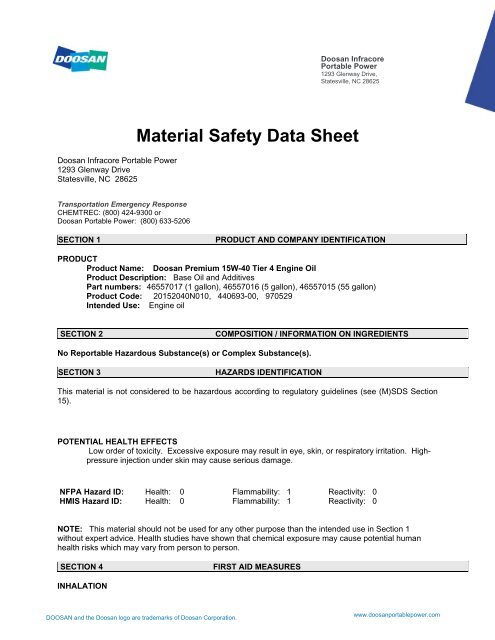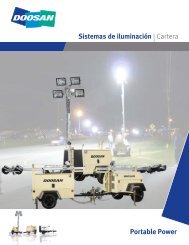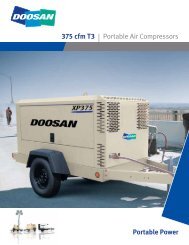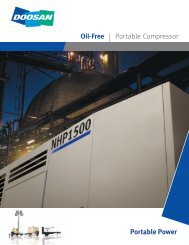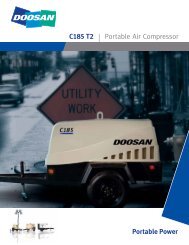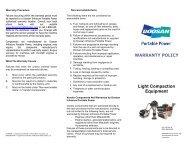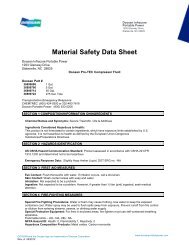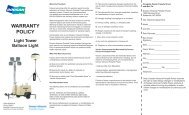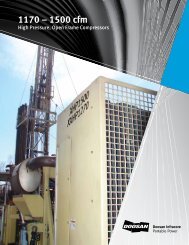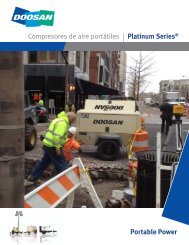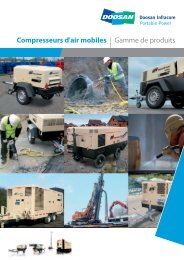Material Safety Data Sheet - Doosan Portable Power
Material Safety Data Sheet - Doosan Portable Power
Material Safety Data Sheet - Doosan Portable Power
Create successful ePaper yourself
Turn your PDF publications into a flip-book with our unique Google optimized e-Paper software.
<strong>Doosan</strong> Infracore<br />
<strong>Portable</strong> <strong>Power</strong><br />
1293 Glenway Drive,<br />
Statesville, NC 28625<br />
<strong>Doosan</strong> Infracore <strong>Portable</strong> <strong>Power</strong><br />
1293 Glenway Drive<br />
Statesville, NC 28625<br />
<strong>Material</strong> <strong>Safety</strong> <strong>Data</strong> <strong>Sheet</strong><br />
Transportation Emergency Response<br />
CHEMTREC: (800) 424-9300 or<br />
<strong>Doosan</strong> <strong>Portable</strong> <strong>Power</strong>: (800) 633-5206<br />
SECTION 1<br />
PRODUCT AND COMPANY IDENTIFICATION<br />
PRODUCT<br />
Product Name:<br />
<strong>Doosan</strong> Premium 15W-40 Tier 4 Engine Oil<br />
Product Description: Base Oil and Additives<br />
Part numbers: 46557017 (1 gallon), 46557016 (5 gallon), 46557015 (55 gallon)<br />
Product Code: 20152040N010, 440693-00, 970529<br />
Intended Use: Engine oil<br />
SECTION 2<br />
COMPOSITION / INFORMATION ON INGREDIENTS<br />
No Reportable Hazardous Substance(s) or Complex Substance(s).<br />
SECTION 3<br />
HAZARDS IDENTIFICATION<br />
This material is not considered to be hazardous according to regulatory guidelines (see (M)SDS Section<br />
15).<br />
POTENTIAL HEALTH EFFECTS<br />
Low order of toxicity. Excessive exposure may result in eye, skin, or respiratory irritation. Highpressure<br />
injection under skin may cause serious damage.<br />
NFPA Hazard ID: Health: 0 Flammability: 1 Reactivity: 0<br />
HMIS Hazard ID: Health: 0 Flammability: 1 Reactivity: 0<br />
NOTE: This material should not be used for any other purpose than the intended use in Section 1<br />
without expert advice. Health studies have shown that chemical exposure may cause potential human<br />
health risks which may vary from person to person.<br />
SECTION 4<br />
FIRST AID MEASURES<br />
INHALATION<br />
DOOSAN and the <strong>Doosan</strong> logo are trademarks of <strong>Doosan</strong> Corporation.<br />
www.doosanportablepower.com
<strong>Doosan</strong> Infracore<br />
<strong>Portable</strong> <strong>Power</strong><br />
1293 Glenway Drive,<br />
Statesville, NC 28625<br />
Remove from further exposure. For those providing assistance, avoid exposure to yourself or<br />
others. Use adequate respiratory protection. If respiratory irritation, dizziness, nausea, or<br />
unconsciousness occurs, seek immediate medical assistance. If breathing has stopped, assist<br />
ventilation with a mechanical device or use mouth-to-mouth resuscitation.<br />
SKIN CONTACT<br />
Wash contact areas with soap and water. If product is injected into or under the skin, or into any<br />
part of the body, regardless of the appearance of the wound or its size, the individual should be<br />
evaluated immediately by a physician as a surgical emergency. Even though initial symptoms<br />
from high pressure injection may be minimal or absent, early surgical treatment within the first few<br />
hours may significantly reduce the ultimate extent of injury.<br />
EYE CONTACT<br />
Flush thoroughly with water. If irritation occurs, get medical assistance.<br />
INGESTION<br />
First aid is normally not required. Seek medical attention if discomfort occurs.<br />
SECTION 5<br />
FIRE FIGHTING MEASURES<br />
EXTINGUISHING MEDIA<br />
Appropriate Extinguishing Media: Use water fog, foam, dry chemical or carbon dioxide (CO2)<br />
to extinguish flames.<br />
Inappropriate Extinguishing Media: Straight Streams of Water<br />
FIRE FIGHTING<br />
Fire Fighting Instructions: Evacuate area. Prevent runoff from fire control or dilution from<br />
entering streams, sewers, or drinking water supply. Firefighters should use standard protective<br />
equipment and in enclosed spaces, self-contained breathing apparatus (SCBA). Use water spray<br />
to cool fire exposed surfaces and to protect personnel.<br />
Hazardous Combustion Products: Smoke, Fume, Aldehydes, Sulfur oxides, Incomplete<br />
combustion products, Oxides of carbon<br />
FLAMMABILITY PROPERTIES<br />
Flash Point [Method]: >215C (419F) [ASTM D-92]<br />
Flammable Limits (Approximate volume % in air): LEL: 0.9 UEL: 7.0<br />
Autoignition Temperature: N/D<br />
SECTION 6<br />
ACCIDENTAL RELEASE MEASURES<br />
NOTIFICATION PROCEDURES<br />
In the event of a spill or accidental release, notify relevant authorities in accordance with all<br />
DOOSAN and the <strong>Doosan</strong> logo are trademarks of <strong>Doosan</strong> Corporation.<br />
www.doosanportablepower.com
<strong>Doosan</strong> Infracore<br />
<strong>Portable</strong> <strong>Power</strong><br />
1293 Glenway Drive,<br />
Statesville, NC 28625<br />
applicable regulations. US regulations require reporting releases of this material to the<br />
environment which exceed the applicable reportable quantity or oil spills which could reach any<br />
waterway including intermittent dry creeks. The National Response Center can be reached at<br />
(800)424-8802.<br />
PROTECTIVE MEASURES<br />
Avoid contact with spilled material. See Section 5 for fire fighting information. See the Hazard<br />
Identification Section for Significant Hazards. See Section 4 for First Aid Advice. See Section 8<br />
for advice on the minimum requirements for personal protective equipment. Additional protective<br />
measures may be necessary, depending on the specific circumstances and/or the expert<br />
judgment of the emergency responders. For emergency responders: Respiratory protection:<br />
respiratory protection will be necessary only in special cases, e.g., formation of mists. Half-face or<br />
full-face respirator with filter(s) for dust/organic vapor or Self Contained Breathing Apparatus<br />
(SCBA) can be used depending on the size of spill and potential level of exposure. If the<br />
exposure cannot be completely characterized or an oxygen deficient atmosphere is possible or<br />
anticipated, SCBA is recommended. Work gloves that are resistant to hydrocarbons are<br />
recommended. Gloves made of polyvinyl acetate (PVA) are not water-resistant and are not<br />
suitable for emergency use. Chemical goggles are recommended if splashes or contact with eyes<br />
is possible. Small spills: normal antistatic work clothes are usually adequate. Large spills: full<br />
body suit of chemical resistant, antistatic material is recommended.<br />
SPILL MANAGEMENT<br />
Land Spill: Stop leak if you can do it without risk. Recover by pumping or with suitable<br />
absorbent.<br />
Water Spill: Stop leak if you can do it without risk. Confine the spill immediately with booms.<br />
Warn other shipping. Remove from the surface by skimming or with suitable absorbents. Seek<br />
the advice of a specialist before using dispersants.<br />
Water spill and land spill recommendations are based on the most likely spill scenario for this<br />
material; however, geographic conditions, wind, temperature, (and in the case of a water spill)<br />
wave and current direction and speed may greatly influence the appropriate action to be taken.<br />
For this reason, local experts should be consulted. Note: Local regulations may prescribe or limit<br />
action to be taken.<br />
ENVIRONMENTAL PRECAUTIONS<br />
Large Spills: Dike far ahead of liquid spill for later recovery and disposal. Prevent entry into<br />
waterways, sewers, basements or confined areas.<br />
SECTION 7<br />
HANDLING AND STORAGE<br />
HANDLING<br />
Avoid contact with used product. Prevent small spills and leakage to avoid slip hazard. <strong>Material</strong><br />
can accumulate static charges which may cause an electrical spark (ignition source). When the<br />
material is handled in bulk, an electrical spark could ignite any flammable vapors from liquids or<br />
residues that may be present (e.g., during switch-loading operations). Use proper bonding and/or<br />
ground procedures. However, bonding and grounds may not eliminate the hazard from static<br />
accumulation. Consult local applicable standards for guidance. Additional references include<br />
DOOSAN and the <strong>Doosan</strong> logo are trademarks of <strong>Doosan</strong> Corporation.<br />
www.doosanportablepower.com
<strong>Doosan</strong> Infracore<br />
<strong>Portable</strong> <strong>Power</strong><br />
1293 Glenway Drive,<br />
Statesville, NC 28625<br />
American Petroleum Institute 2003 (Protection Against Ignitions Arising out of Static, Lightning<br />
and Stray Currents) or National Fire Protection Agency 77 (Recommended Practice on Static<br />
Electricity) or CENELEC CLC/TR 50404 (Electrostatics - Code of practice for the avoidance of<br />
hazards due to static electricity).<br />
Static Accumulator: This material is a static accumulator.<br />
STORAGE<br />
The container choice, for example storage vessel, may effect static accumulation and dissipation.<br />
Do not store in open or unlabelled containers.<br />
SECTION 8<br />
EXPOSURE CONTROLS / PERSONAL PROTECTION<br />
Exposure limits/standards for materials that can be formed when handling this product: When<br />
mists/aerosols can occur the following are recommended: 5 mg/m³ - ACGIH TLV (inhalable fraction), 5<br />
mg/m³ - OSHA PEL.<br />
NOTE: Limits/standards shown for guidance only. Follow applicable regulations.<br />
ENGINEERING CONTROLS<br />
The level of protection and types of controls necessary will vary depending upon potential<br />
exposure conditions. Control measures to consider:<br />
No special requirements under ordinary conditions of use and with adequate ventilation.<br />
PERSONAL PROTECTION<br />
Personal protective equipment selections vary based on potential exposure conditions such as<br />
applications, handling practices, concentration and ventilation. Information on the selection of<br />
protective equipment for use with this material, as provided below, is based upon intended,<br />
normal usage.<br />
Respiratory Protection: If engineering controls do not maintain airborne contaminant<br />
concentrations at a level which is adequate to protect worker health, an approved respirator may<br />
be appropriate. Respirator selection, use, and maintenance must be in accordance with<br />
regulatory requirements, if applicable. Types of respirators to be considered for this material<br />
include:<br />
No special requirements under ordinary conditions of use and with adequate ventilation.<br />
For high airborne concentrations, use an approved supplied-air respirator, operated in positive<br />
pressure mode. Supplied air respirators with an escape bottle may be appropriate when oxygen<br />
levels are inadequate, gas/vapor warning properties are poor, or if air purifying filter<br />
capacity/rating may be exceeded.<br />
DOOSAN and the <strong>Doosan</strong> logo are trademarks of <strong>Doosan</strong> Corporation.<br />
www.doosanportablepower.com
<strong>Doosan</strong> Infracore<br />
<strong>Portable</strong> <strong>Power</strong><br />
1293 Glenway Drive,<br />
Statesville, NC 28625<br />
Hand Protection: Any specific glove information provided is based on published literature and<br />
glove manufacturer data. Glove suitability and breakthrough time will differ depending on the<br />
specific use conditions. Contact the glove manufacturer for specific advice on glove selection and<br />
breakthrough times for your use conditions. Inspect and replace worn or damaged gloves. The<br />
types of gloves to be considered for this material include:<br />
No protection is ordinarily required under normal conditions of use.<br />
Eye Protection: If contact is likely, safety glasses with side shields are recommended.<br />
Skin and Body Protection: Any specific clothing information provided is based on published<br />
literature or manufacturer data. The types of clothing to be considered for this material include:<br />
No skin protection is ordinarily required under normal conditions of use. In accordance<br />
with good industrial hygiene practices, precautions should be taken to avoid skin contact.<br />
Specific Hygiene Measures: Always observe good personal hygiene measures, such as<br />
washing after handling the material and before eating, drinking, and/or smoking. Routinely wash<br />
work clothing and protective equipment to remove contaminants. Discard contaminated clothing<br />
and footwear that cannot be cleaned. Practice good housekeeping.<br />
ENVIRONMENTAL CONTROLS<br />
See Sections 6, 7, 12, 13.<br />
SECTION 9<br />
PHYSICAL AND CHEMICAL PROPERTIES<br />
Note: Physical and chemical properties are provided for safety, health and environmental<br />
considerations only and may not fully represent product specifications. Contact the Supplier for<br />
additional information.<br />
GENERAL INFORMATION<br />
Physical State: Liquid<br />
Color: Amber<br />
Odor: Characteristic<br />
Odor Threshold: N/D<br />
IMPORTANT HEALTH, SAFETY, AND ENVIRONMENTAL INFORMATION<br />
Relative Density (at 15 C): 0.874<br />
Flash Point [Method]: >215C (419F) [ASTM D-92]<br />
Flammable Limits (Approximate volume % in air): LEL: 0.9 UEL: 7.0<br />
Autoignition Temperature: N/D<br />
Boiling Point / Range: > 316C (600F)<br />
Vapor Density (Air = 1): N/D<br />
Vapor Pressure: < 0.013 kPa (0.1 mm Hg) at 20 C<br />
Evaporation Rate (n-butyl acetate = 1): N/D<br />
pH: N/A<br />
Log Pow (n-Octanol/Water Partition Coefficient): > 3.5<br />
Solubility in Water: Negligible<br />
Viscosity: 113 cSt (113 mm2/sec) at 40 C | 15 cSt (15 mm2/sec) at 100C<br />
Oxidizing Properties: See Hazards Identification Section.<br />
DOOSAN and the <strong>Doosan</strong> logo are trademarks of <strong>Doosan</strong> Corporation.<br />
www.doosanportablepower.com
<strong>Doosan</strong> Infracore<br />
<strong>Portable</strong> <strong>Power</strong><br />
1293 Glenway Drive,<br />
Statesville, NC 28625<br />
OTHER INFORMATION<br />
Freezing Point: N/D<br />
Melting Point: N/A<br />
Pour Point: -27°C (-17°F)<br />
DMSO Extract (mineral oil only), IP-346:<br />
Decomposition Temperature: N/D<br />
< 3 %wt<br />
SECTION 10<br />
STABILITY AND REACTIVITY<br />
STABILITY: <strong>Material</strong> is stable under normal conditions.<br />
CONDITIONS TO AVOID: Excessive heat. High energy sources of ignition.<br />
MATERIALS TO AVOID: Strong oxidizers<br />
HAZARDOUS DECOMPOSITION PRODUCTS: <strong>Material</strong> does not decompose at ambient temperatures.<br />
HAZARDOUS POLYMERIZATION: Will not occur.<br />
SECTION 11<br />
ACUTE TOXICITY<br />
Route of Exposure<br />
Inhalation<br />
Toxicity (Rat): LC50 > 5000 mg/m3<br />
Irritation: No end point data.<br />
Ingestion<br />
Toxicity (Rat): LD50 > 5000 mg/kg<br />
Skin<br />
Toxicity (Rabbit): LD50 > 5000 mg/kg<br />
Irritation (Rabbit): <strong>Data</strong> available.<br />
Eye<br />
Irritation (Rabbit): <strong>Data</strong> available.<br />
TOXICOLOGICAL INFORMATION<br />
Conclusion / Remarks<br />
Minimally Toxic. Based on test data for structurally similar<br />
materials.<br />
Negligible hazard at ambient/normal handling temperatures.<br />
Based on assessment of the components.<br />
Minimally Toxic. Based on test data for structurally similar<br />
materials.<br />
Minimally Toxic. Based on test data for structurally similar<br />
materials.<br />
Negligible irritation to skin at ambient temperatures. Based on test<br />
data for structurally similar materials.<br />
May cause mild, short-lasting discomfort to eyes. Based on test<br />
data for structurally similar materials.<br />
CHRONIC/OTHER EFFECTS<br />
For the product itself:<br />
Diesel engine oils: Not carcinogenic in animals tests. Used and unused diesel engine oils did<br />
not produce any carcinogenic effects in chronic mouse skin painting studies.<br />
Oils that are used in gasoline engines may become hazardous and display the following<br />
properties: Carcinogenic in animal tests. Caused mutations in vitro. Possible allergen and<br />
photoallergen. Contains polycyclic aromatic compounds (PAC) from combustion products of<br />
DOOSAN and the <strong>Doosan</strong> logo are trademarks of <strong>Doosan</strong> Corporation.<br />
www.doosanportablepower.com
<strong>Doosan</strong> Infracore<br />
<strong>Portable</strong> <strong>Power</strong><br />
1293 Glenway Drive,<br />
Statesville, NC 28625<br />
gasoline and/or thermal degradation products.<br />
Contains:<br />
Base oil severely refined: Not carcinogenic in animal studies. Representative material passes IP-<br />
346, Modified Ames test, and/or other screening tests. Dermal and inhalation studies showed<br />
minimal effects; lung non-specific infiltration of immune cells, oil deposition and minimal<br />
granuloma formation. Not sensitizing in test animals.<br />
Additional information is available by request.<br />
The following ingredients are cited on the lists below: None.<br />
--REGULATORY LISTS SEARCHED--<br />
1 = NTP CARC 3 = IARC 1 5 = IARC 2B<br />
2 = NTP SUS 4 = IARC 2A 6 = OSHA CARC<br />
SECTION 12<br />
ECOLOGICAL INFORMATION<br />
The information given is based on data available for the material, the components of the material, and<br />
similar materials.<br />
ECOTOXICITY<br />
<strong>Material</strong> -- Not expected to be harmful to aquatic organisms.<br />
MOBILITY<br />
Base oil component -- Low solubility and floats and is expected to migrate from water to the land.<br />
Expected to partition to sediment and wastewater solids.<br />
PERSISTENCE AND DEGRADABILITY<br />
Biodegradation:<br />
Base oil component -- Expected to be inherently biodegradable<br />
BIOACCUMULATION POTENTIAL<br />
Base oil component -- Has the potential to bioaccumulate, however metabolism or physical<br />
properties may reduce the bioconcentration or limit bioavailability.<br />
SECTION 13<br />
DISPOSAL CONSIDERATIONS<br />
Disposal recommendations based on material as supplied. Disposal must be in accordance with current<br />
applicable laws and regulations, and material characteristics at time of disposal.<br />
DISPOSAL RECOMMENDATIONS<br />
DOOSAN and the <strong>Doosan</strong> logo are trademarks of <strong>Doosan</strong> Corporation.<br />
www.doosanportablepower.com
<strong>Doosan</strong> Infracore<br />
<strong>Portable</strong> <strong>Power</strong><br />
1293 Glenway Drive,<br />
Statesville, NC 28625<br />
Product is suitable for burning in an enclosed controlled burner for fuel value or disposal by<br />
supervised incineration at very high temperatures to prevent formation of undesirable combustion<br />
products. Protect the environment. Dispose of used oil at designated sites. Minimize skin contact.<br />
Do not mix used oils with solvents, brake fluids or coolants.<br />
REGULATORY DISPOSAL INFORMATION<br />
RCRA Information: The unused product, in our opinion, is not specifically listed by the EPA as a<br />
hazardous waste (40 CFR, Part 261D), nor is it formulated to contain materials which are listed as<br />
hazardous wastes. It does not exhibit the hazardous characteristics of ignitability, corrositivity or<br />
reactivity and is not formulated with contaminants as determined by the Toxicity Characteristic<br />
Leaching Procedure (TCLP). However, used product may be regulated.<br />
Empty Container Warning Empty Container Warning (where applicable): Empty containers may contain<br />
residue and can be dangerous. Do not attempt to refill or clean containers without proper instructions.<br />
Empty drums should be completely drained and safely stored until appropriately reconditioned or<br />
disposed. Empty containers should be taken for recycling, recovery, or disposal through suitably qualified<br />
or licensed contractor and in accordance with governmental regulations. DO NOT PRESSURISE, CUT,<br />
WELD, BRAZE, SOLDER, DRILL, GRIND, OR EXPOSE SUCH CONTAINERS TO HEAT, FLAME,<br />
SPARKS, STATIC ELECTRICITY, OR OTHER SOURCES OF IGNITION. THEY MAY EXPLODE AND<br />
CAUSE INJURY OR DEATH.<br />
SECTION 14<br />
TRANSPORT INFORMATION<br />
LAND (DOT): Not Regulated for Land Transport<br />
LAND (TDG): Not Regulated for Land Transport<br />
SEA (IMDG): Not Regulated for Sea Transport according to IMDG-Code<br />
AIR (IATA): Not Regulated for Air Transport<br />
SECTION 15<br />
REGULATORY INFORMATION<br />
OSHA HAZARD COMMUNICATION STANDARD: When used for its intended purposes, this material is<br />
not classified as hazardous in accordance with OSHA 29 CFR 1910.1200.<br />
Complies with the following national/regional chemical inventory requirements:: KECI, TSCA, DSL<br />
Special Cases:<br />
Inventory<br />
AICS<br />
ELINCS<br />
IECSC<br />
PICCS<br />
Status<br />
Restrictions Apply<br />
Restrictions Apply<br />
Restrictions Apply<br />
Restrictions Apply<br />
EPCRA: This material contains no extremely hazardous substances.<br />
DOOSAN and the <strong>Doosan</strong> logo are trademarks of <strong>Doosan</strong> Corporation.<br />
www.doosanportablepower.com
<strong>Doosan</strong> Infracore<br />
<strong>Portable</strong> <strong>Power</strong><br />
1293 Glenway Drive,<br />
Statesville, NC 28625<br />
SARA (311/312) REPORTABLE HAZARD CATEGORIES: None.<br />
SARA (313) TOXIC RELEASE INVENTORY: This material contains no chemicals subject to the supplier<br />
notification requirements of the SARA 313 Toxic Release Program.<br />
The following ingredients are cited on the lists below:<br />
Chemical Name CAS Number List Citations<br />
DIPHENYLAMINE 122-39-4 5, 18<br />
ZINC DITHIOPHOSPHATE 68649-42-3 15<br />
--REGULATORY LISTS SEARCHED--<br />
1 = ACGIH ALL 6 = TSCA 5a2 11 = CA P65 REPRO 16 = MN RTK<br />
2 = ACGIH A1 7 = TSCA 5e 12 = CA RTK 17 = NJ RTK<br />
3 = ACGIH A2 8 = TSCA 6 13 = IL RTK 18 = PA RTK<br />
4 = OSHA Z 9 = TSCA 12b 14 = LA RTK 19 = RI RTK<br />
5 = TSCA 4 10 = CA P65 CARC 15 = MI 293<br />
Code key: CARC=Carcinogen; REPRO=Reproductive<br />
SECTION 16<br />
OTHER INFORMATION<br />
N/D = Not determined, N/A = Not applicable<br />
THIS SAFETY DATA SHEET CONTAINS THE FOLLOWING REVISIONS:<br />
Revision Changes:<br />
Section 09: Phys/Chem Properties Note was modified.<br />
Hazard Identification: Health Hazards was modified.<br />
Section 09: Flash Point C(F) was modified.<br />
Section 15: List Citations Table was modified.<br />
Section 08: Exposure limits/standards was modified.<br />
The above information is based on the data of which we are aware and is believed to be correct as of the<br />
date hereof. Since this information may be applied under conditions beyond our control and with which<br />
we may be unfamiliar and since data made available subsequent to the date hereof may suggest<br />
modifications of the information, we do not assume any responsibility for the results of its use. This<br />
information is furnished upon condition that the person receiving it shall make his own determination of<br />
the suitability of the material for his particular purpose.<br />
DOOSAN and the <strong>Doosan</strong> logo are trademarks of <strong>Doosan</strong> Corporation.<br />
www.doosanportablepower.com


